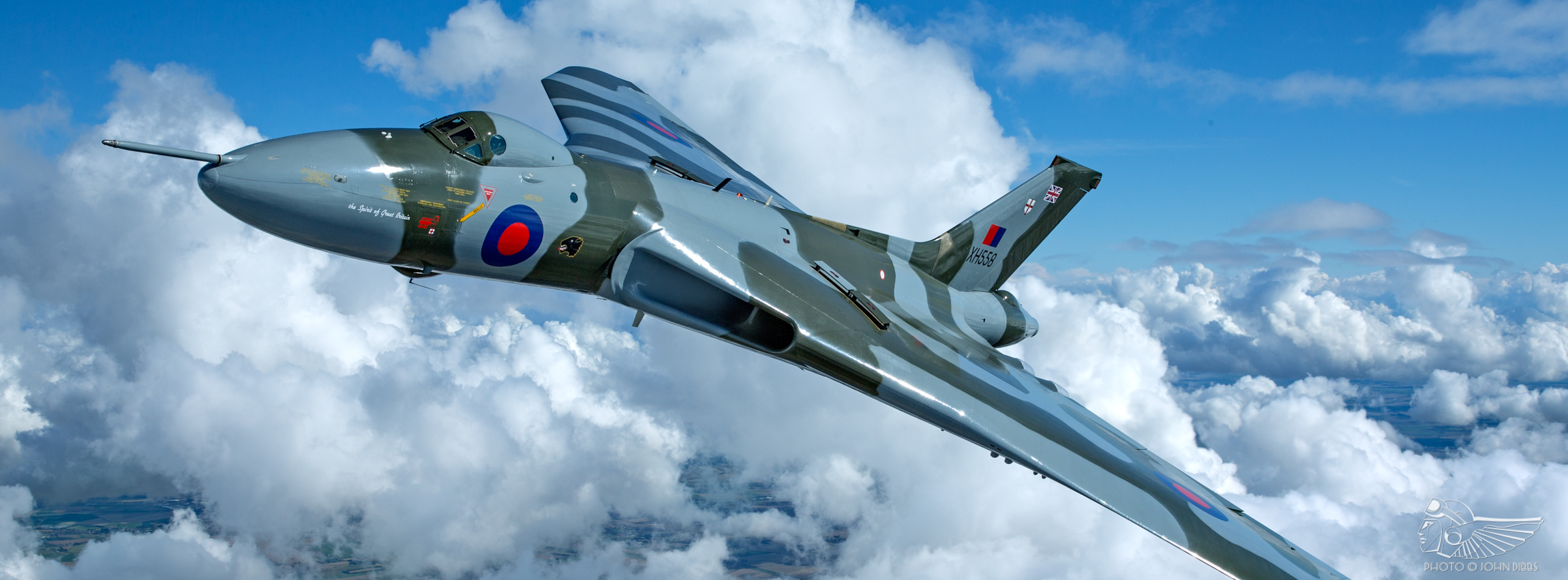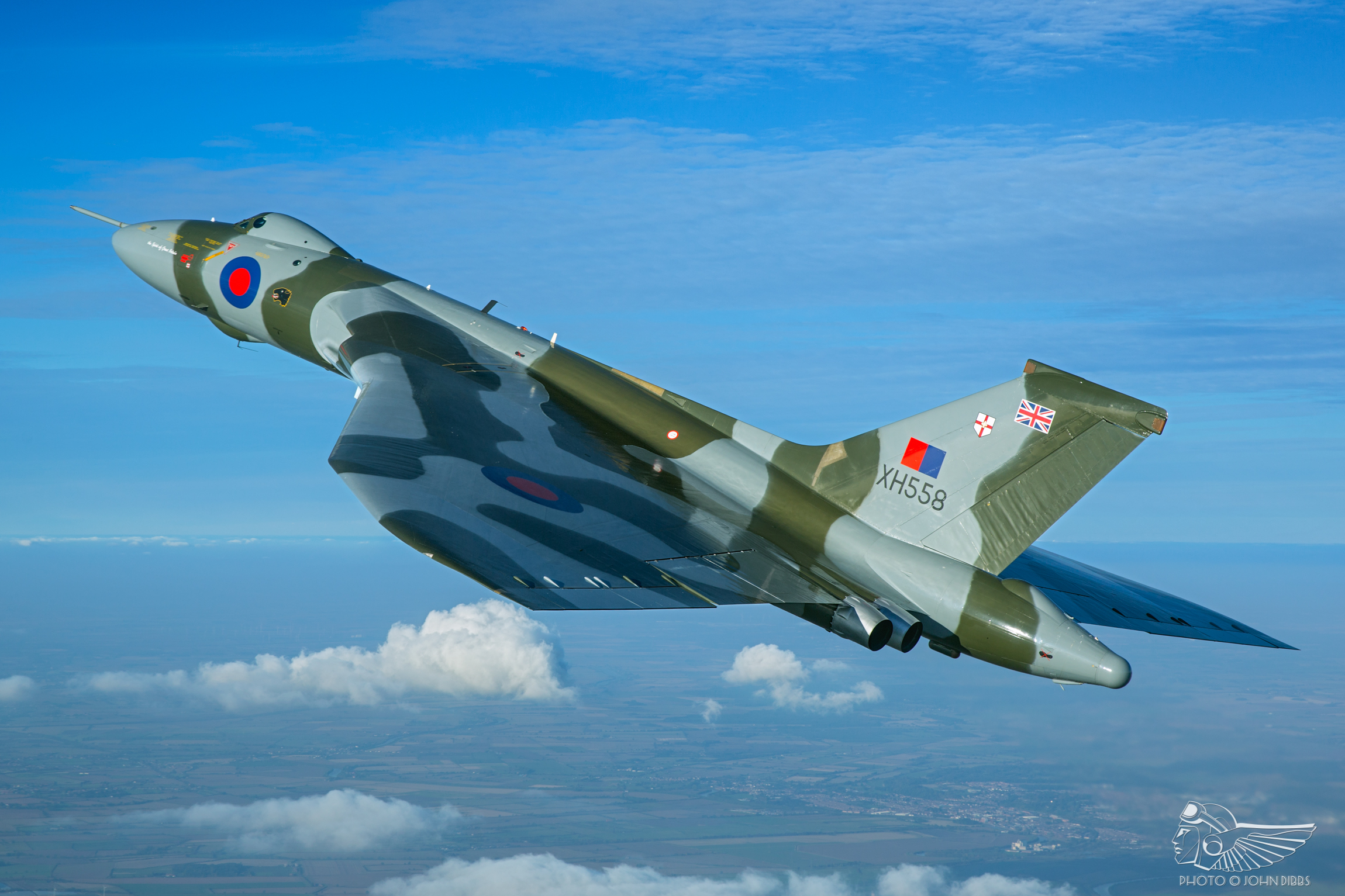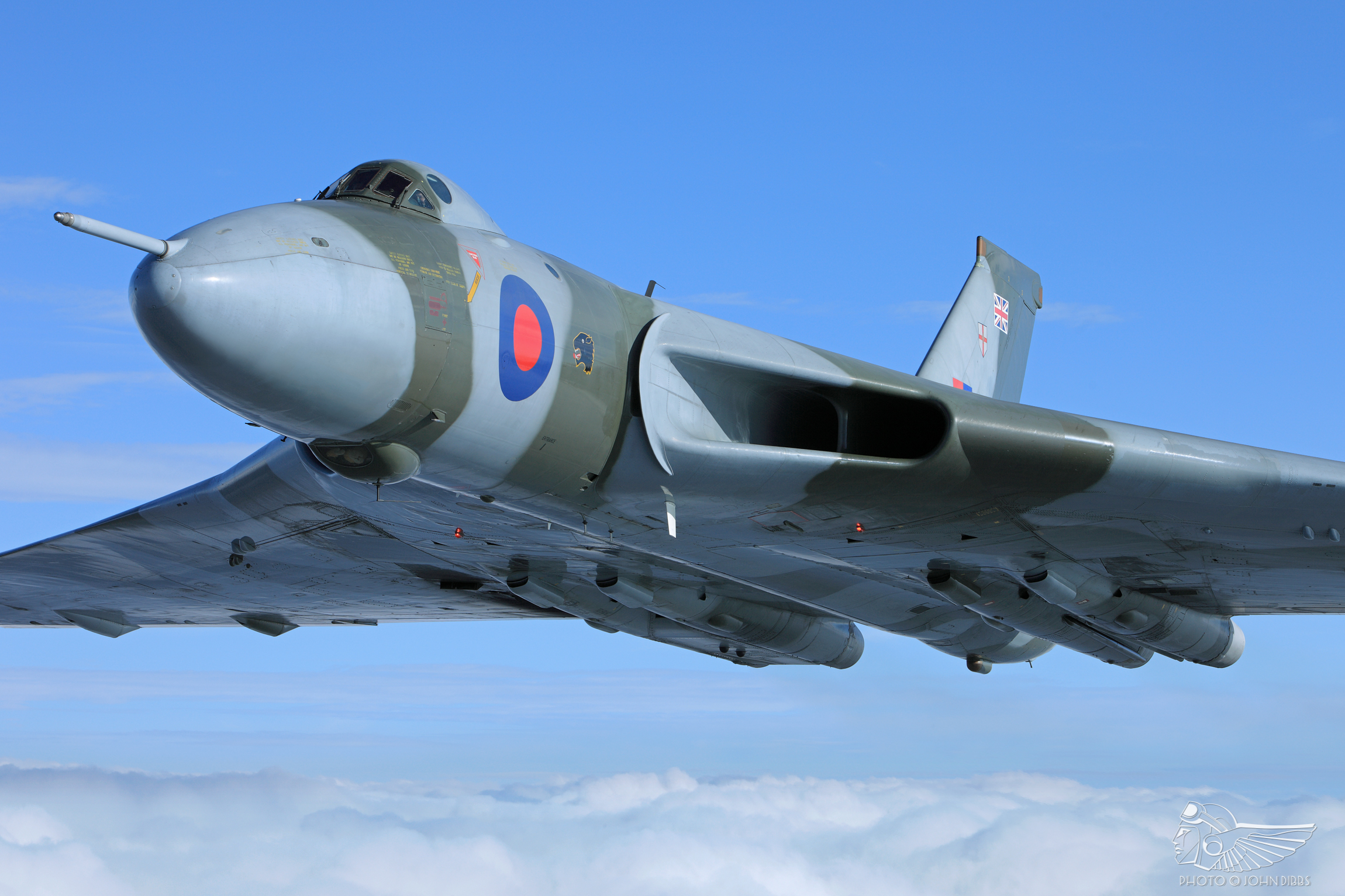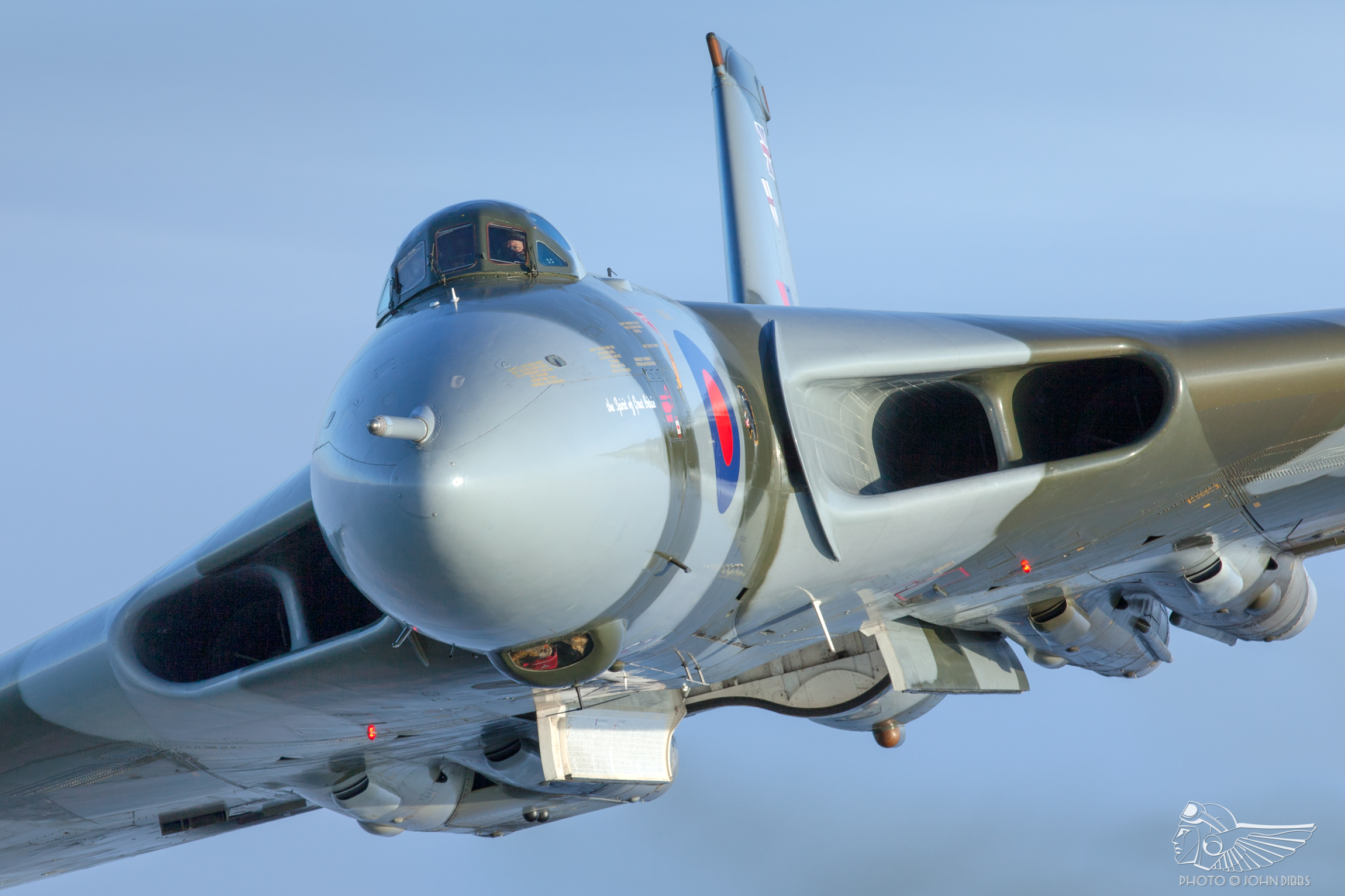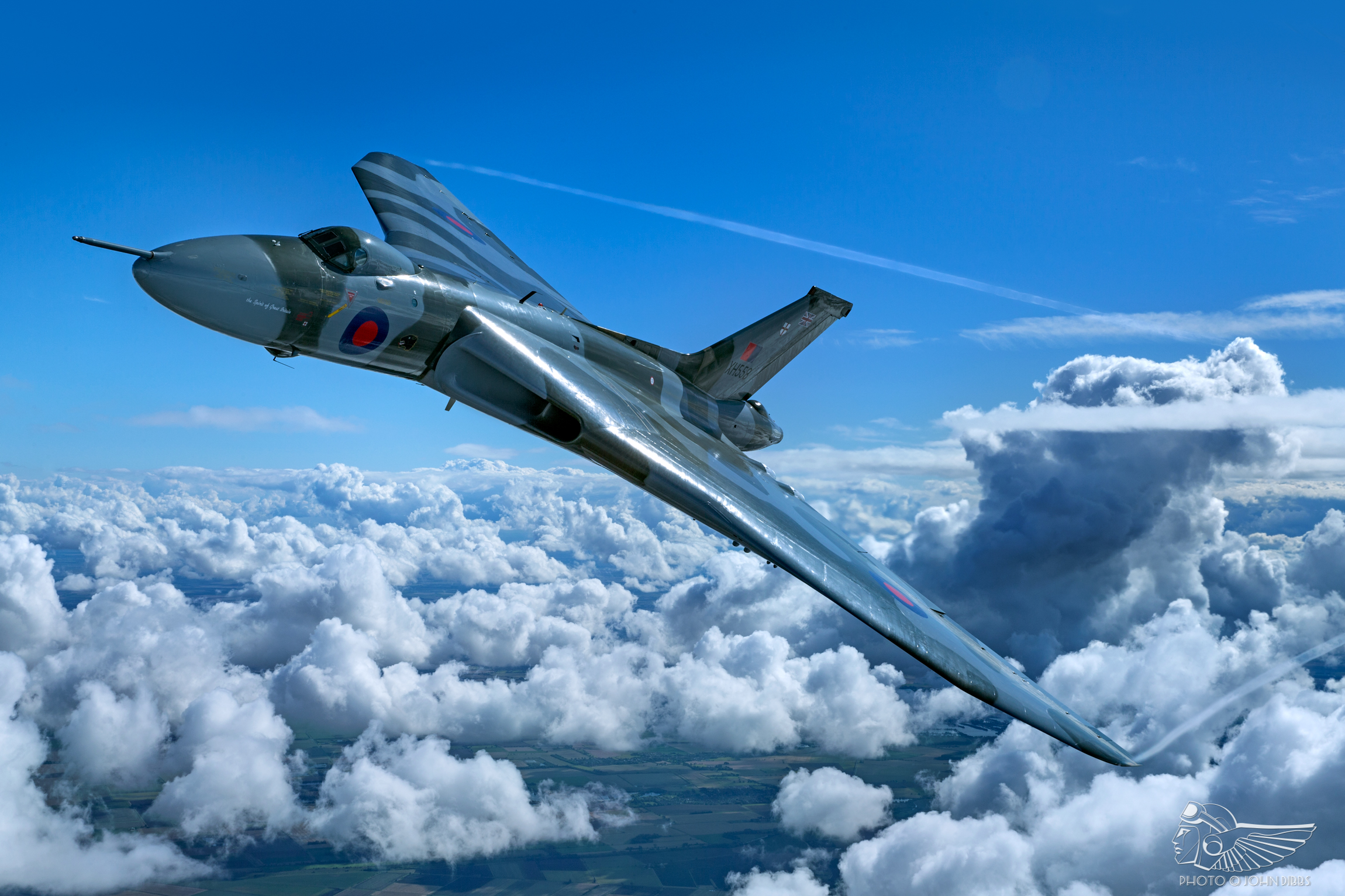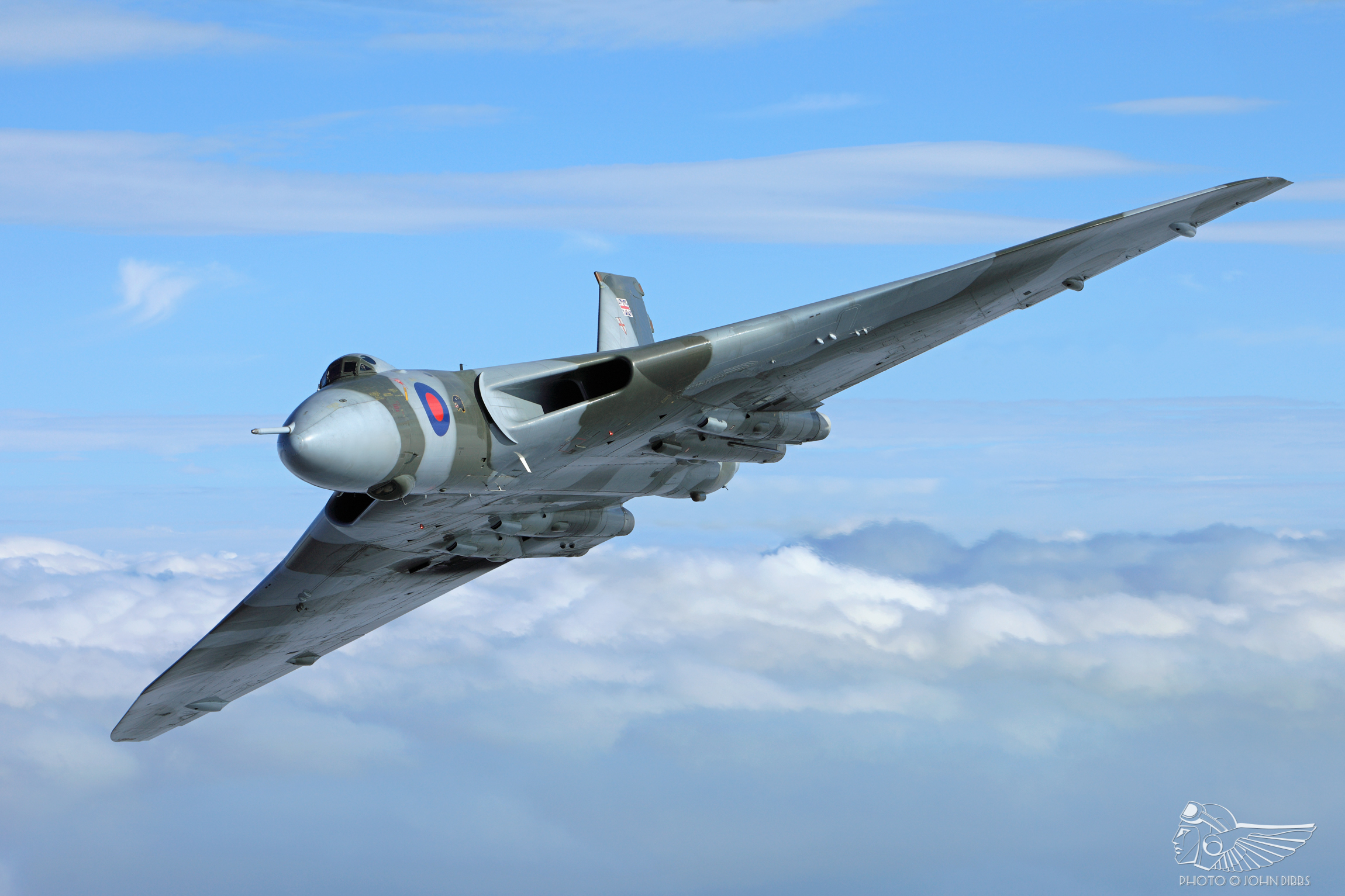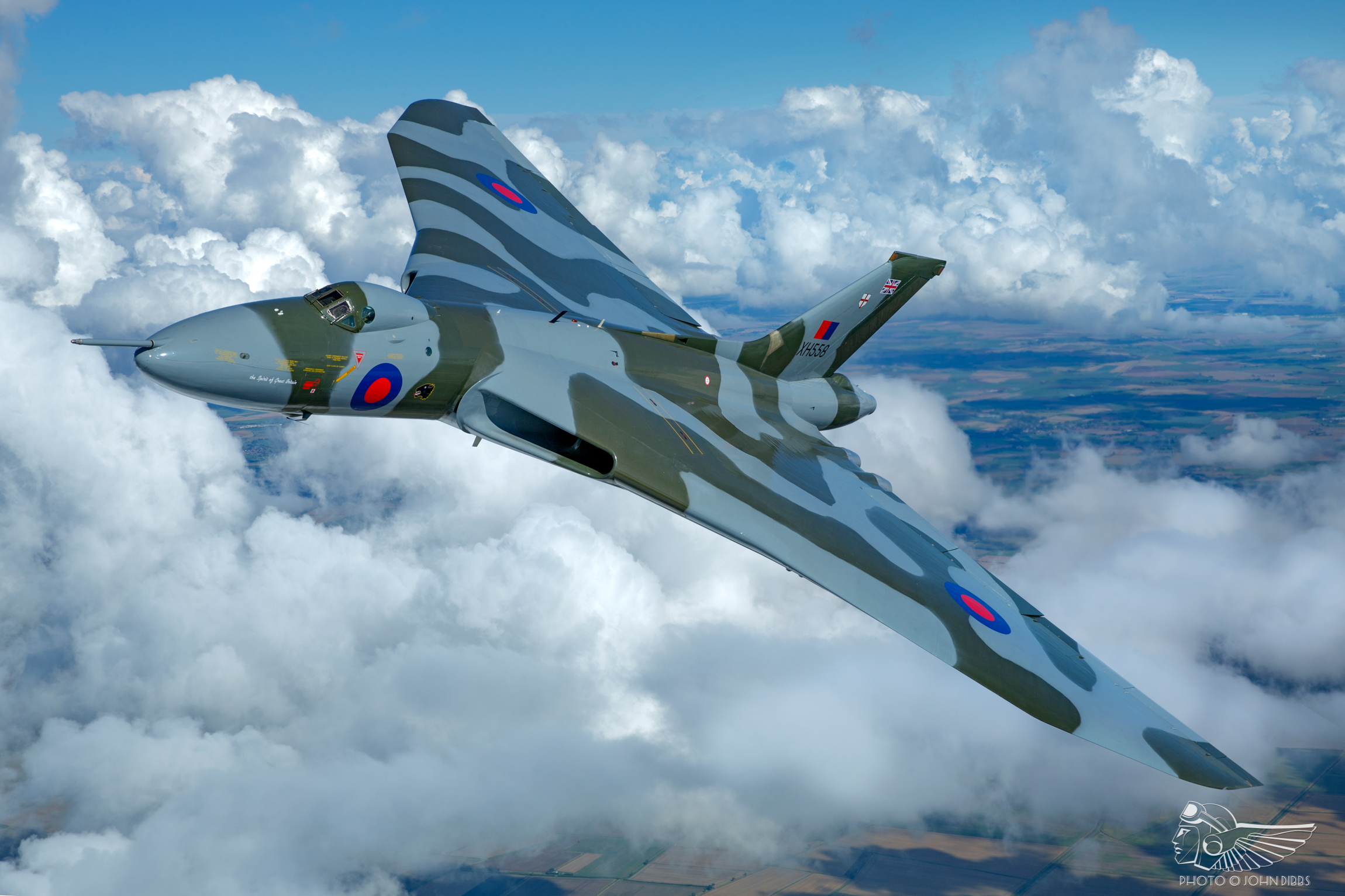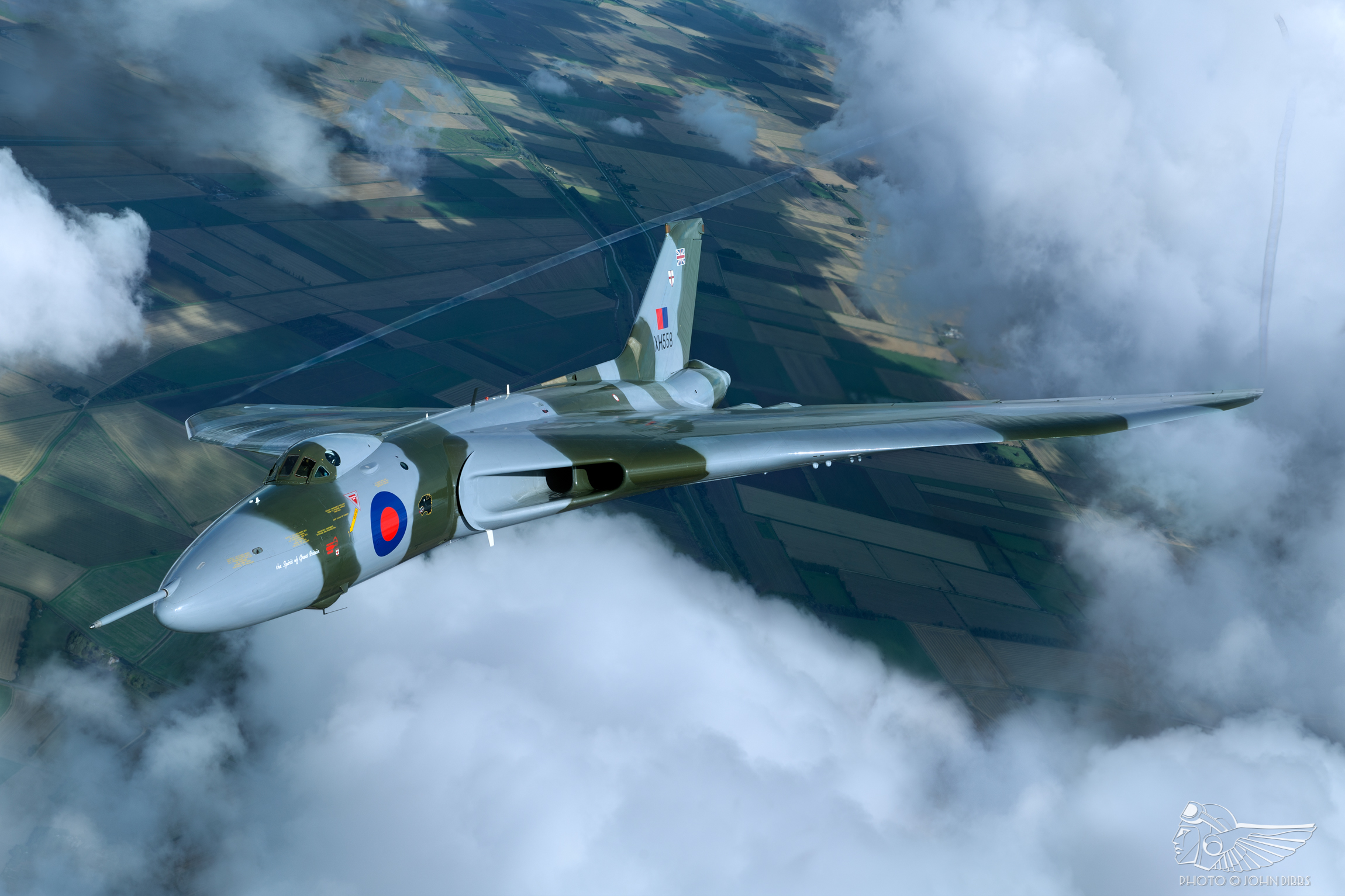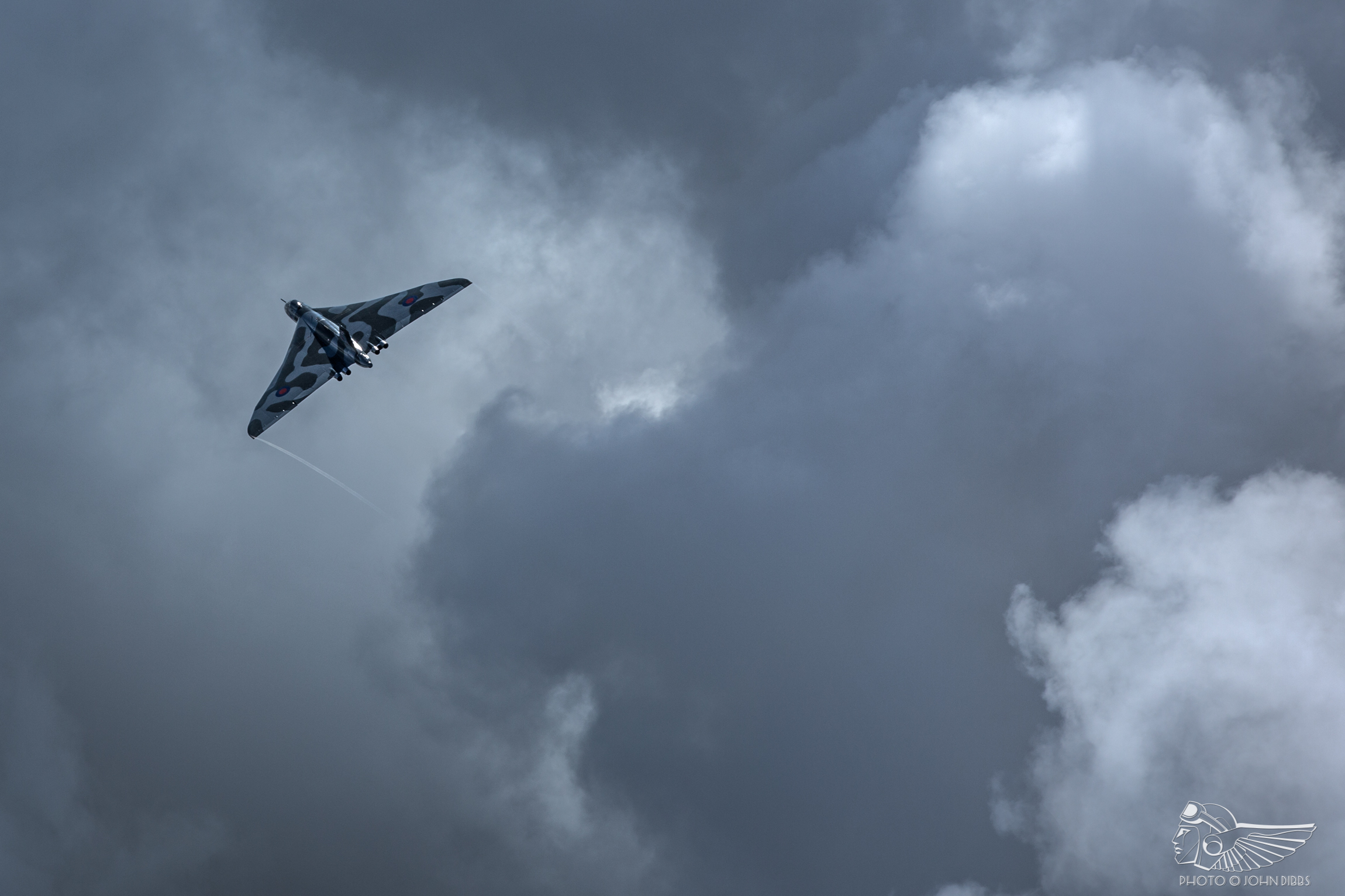When Flight Lieutenant Bill Ramsey stepped out of the Avro Vulcan for the last time in Royal Air Force service on 9 May 1978, he had every reason to believe his days flying the aging delta-wing bomber were over. “All I ever wanted to do was fly fast-jets, and I couldn’t wait to leave the Vulcan squadrons”, he remembers. 33 years later, Bill was back in the cockpit of the world’s only airworthy Vulcan to begin what amounted to a further four years’ flying in the civilian world. “It’s funny how things work out!”
The Vulcan carried out its maiden flight on 30 August 1952, joining the RAF in summer 1956 and remaining on strength until March 1984. “Watching the Vulcan flying at Farnborough in the early 1950s must have been like seeing the USS Enterprise”, Bill muses. “The aircraft had such a distinctive appearance, and the step-up in technology from its predecessors was amazing. The systems on the aeroplane and the level of redundancy built into the flying controls and electrical systems was incredible. Every year I came away from our ground refresher school thinking, ‘How did they come up with that?’ It’s easy to overlook that now.”
Vulcan B Mk.2 XH558 was manufactured by AV Roe & Co Ltd and made its maiden flight from Woodford on 25 May 1960. Its arrival at RAF Waddington’s No. 230 Operational Conversion Unit in July 1960 marked the delivery of the first Vulcan B2 to the RAF. During its service life the aircraft underwent conversion to maritime reconnaissance B2 (SR2) and air-to-air tanker K2 configurations. The aircraft was stood down from active service in 1984 and thereafter the RAF continued to operate XH558 under the Vulcan Display Flight banner, during which time it became an immensely popular solo performer on the British airshow circuit. After retirement from RAF service in 1992, XH558 was delivered to its new private owners, the Walton family, at Bruntingthorpe airfield on 23 March 1993.
There the Waltons maintained the Vulcan in taxiing condition until the decision was taken to return the aircraft to airworthiness. A colossally expensive decade-long restoration, which included both National Lottery funding and donations of several millions pounds, culminated in the Vulcan’s return to flight at Bruntingthorpe on 18 October 2007. It was – and still is – the most complex type to ever be operated by civilian hands in the UK. Flight testing concluded in early June 2008 and the following month the aircraft appropriately made its much anticipated public airshow début at its former base at RAF Waddington in front of an estimated 125,000 spectators. “This is the bomber controller”, a Cold War RAF operator’s voice echoed across the air base as the Vulcan’s engines spooled up into that characteristic haunting howl, “Scramble! Scramble! Scramble!” For the next seven years the Vulcan was once more an airshow mainstay, drawing huge crowds and receiving millions of pounds in personal donations as a testament to its popularity with enthusiasts and the general public alike. Its reception was unprecedented; Vulcan fans turned out in their droves to catch a glimpse of XH558 in the air, the wider support for the project unwavering even in the wake of repeated funding appeals and technical issues. Vulcan XH558 carried out its final flight on 28 October 2015, retiring to Doncaster Sheffield Airport (formerly RAF Finningley) under the care and maintenance of the Vulcan to the Sky Trust.
Bill’s introduction to the Vulcan ‘558 display crew came during the winter of 2011. “I had just finished displaying the Tutor”, he remembers. “I was at a lunch to say cheerio to a friend at RAF Cranwell when I met XH558’s Operations Director, Mike Pollitt. We had a few beers and he said, ‘Why don’t you come and fly the Vulcan with us?’ I figured he’d had too many and thought little of it, but to my surprise a couple of days later I received a ‘phone call from Martin Withers, who asked if I wanted to have a chat about joining the team.” Shortly thereafter, Bill was accepted onto the XH558 display aircrew and invited to join the pre-season intensive ground school refresher course, held annually at one of the team’s homes. In late-March, the whole team headed to Wellesbourne aerodrome to spend a couple of days carrying out systems and ground handling training on ‘live’ Vulcan B.2 XM655. This involved running through a series of in-cockpit pre-flight procedures, taxi runs and simulated in-flight emergency drills, including double engine failures and evacuations.
The Wellesbourne trip marked Bill’s first time at the controls of a Vulcan in almost 33 years. He had joined the RAF in 1972, trained on Chipmunks and Jet Provosts, progressed to the Varsity and volunteered to fly the Vulcan with No. 35 Squadron at RAF Scampton in 1975. When he stepped away from Vulcan XM570 at the end of his last operational flight in May 1978 to begin a new career as a fast-jet pilot on the Tornado, he had every reason to believe his Vulcan days had ended after three years and 760 hours on type. “Most of it came back quickly”, Bill remembers, “but the small panel on the right of the cockpit completely lost me – not particularly great, as that was vital to starting the engines!” Skip forward two months, and Bill was rostered to fly XH558 for the first time. It was 29 May 2011, and the aircraft was visiting its former Bruntingthorpe home for the popular Cold War Jets Open Day.
“As I made my way through the crowds, I realised to my absolute horror that there appeared to be a lot of people waiting for the Vulcan to depart”, he recalls. “My main feeling, above all else, was fear!” Bill went on to fly XH558 until its last flight in October 2015. Displaying the aircraft presented a whole raft of unique challenges quite unlike any experienced on military or civilian types. “I’d displayed light trainers, fast-jets and Second World War bombers before, but nothing compares to the Vulcan”, he recollects. “It was a genuine honour, but the privilege came with great responsibility. The workload for the pilot was high, the Vulcan commanded respect, and you absolutely had to be at the top of your game every time you strapped into the cockpit.”
Whilst in-service Vulcans operated with a crew of five – pilot, co-pilot, navigator/radar operator, navigator/plotter and Air Electronics Officer (AEO) – XH558 typically flew with just three on board during its comeback, the crew comprising pilot (Captain), co-pilot and AEO, with a Crew Chief or engineer optional for deployments away from home. Crewing in typically began an hour before scheduled take-off time, the three members accessing the aircraft via a hatch on the underside of the cockpit. The pilots sat side-by-side in Martin Baker ejector seats on a raised platform at the front of the cabin, the “cramped and cosy” cockpit necessitating a lightly gymnastic approach to crewing in. Once strapped in, Bill spent his sorties in the Vulcan leaning his 6’1″ frame either left or right (depending on which seat he occupied), the curved cabin impairing his ability to sit upright. The AEO and any supplementary aircrew sat behind the pilots on aft-facing swivel seats with no means of ejecting; in the event of an emergency, they would evacuate the aircraft through the underside access hatch.
Vulcan XH558’s restored cockpit was slightly different to the in-service aircraft Bill had flown during the 1970s. Surplus military-era systems such as the radar and weapons controls had been removed, making for a sparse panel with the essential instrumentation, including a modern artificial attitude indicator and original rpm indicator, jet pipe temperatures and oil pressure gauges grouped in the centre. Additional panels for the engine and flying controls sat on either side of the cockpit. The pilots operated dual interconnected control columns with pitch and roll trim toggles at the top of the stick and the throttle quadrant positioned between them. Navigation equipment varied from 2007 to 2015, with a range of GPS tablet devices introduced sequentially. During Bill’s tenure on the ‘558 team, iPad Minis were in use in combination with a GPS receiver attached to the instrument panel – this enabled the aircrew to use a moving map when navigating, and Bill recalls the software offered a great deal more flexibility during long-distance transits, particularly when trying to circumnavigate poor weather.
As the Captain programmed each of the transit route waypoints into the onboard GPS system (if applicable), the co-pilot checked the fuel content in each of the 14 tanks (with a maximum capacity of 65,000 lbs), noting down the capacities, calculating the pre-start centre of gravity (CoG) and manually working out the CoG at the time of take-off, based on the predicted fuel burn in the respective tanks, using a ‘slip-stick’ cursor. Each pair of tanks carried different fuel loads, and the co-pilot was responsible for establishing which tanks might need to be selected on the ground in order to burn requisite fuel to move the CoG far enough aft for the nose to get off the ground on take-off. Start-up was initiated around 25-minutes before take-off, normally via an external 28/200-volt power source and Palouste starter unit. The pilot(s) first ran through the cockpit to ensure all electrics were switched off – turning on the alternators with the switches active could shock load the system. The AEO then activated each system in turn, building up the electrical loads slowly to avoid overloading the systems.
In-service Vulcans could be started in myriad ways, including a cartridge start or initiating full-power on one engine and using bleed air to start the three other engine simultaneously. The external Palouste was typically used for all civilian flights. The Crew Chief on the ground ran the Palouste to its operating rpm, the Captain then opening the air feed to the number one engine to blow the fans to the point they were self-sustaining. At that point, the Captain nudged the throttle forward to open the high-pressure cock, as the co-pilot monitored fuel flow and fired the igniters within the engine. With rpm and oil pressure rising, the high-pressure cock on the throttle was opened all the way and clicked over into Idle power. The sequence was then repeated for the other three engines, typically taking 30 seconds apiece.
A powerful nose wheel steering system made ground handling straightforward, the Vulcan’s poor visibility offering the only cause for concern when taxiing on a busy apron. With the cockpit positioned forward of the nose wheel, care had to be taken to avoid turning too soon and rolling the aircraft onto the grass beside the taxiway. Pre-take-off checks were carried out with the aircraft positioned at the runway threshold before lining up for departure; with the engine temperatures and pressures looking good, Bill would hold the Vulcan on its brakes and set 80% rpm across all four engines, checking for asymmetric thrust. Advancing the throttles to 100% rpm (Full Power), the brakes were released and the Vulcan accelerated rapidly as Bill maintained positioning using the nose-wheel steering mid-way down the stick. As the aircraft passed 100kts and the rudder attained sufficient authority, Bill would remove his thumb from the nose-wheel steering button on the stick and slide his hand up the control column, “an awkward thing to do at that speed”, using the pendulum-type rudder pedals to correct any deviations. The Vulcan’s enormous delta-wing profile yearned to pull the aircraft into the air, and an inch of forward stick pressure was required to pin the nose-wheel to the runway until rotation airspeed.
At 135kts the aircraft rotated without any need to apply back pressure to the stick, and a 45° angle could be comfortably maintained during the initial climb-out. “Raising the undercarriage at that point was important”, recalls Bill, “both to ensure that it didn’t exceed the gear limit speed and in case of an emergency. If we had a major emergency, the undercarriage being down would impair the AEO’s ability to bail out of the crew door”. Producing 17,000Ibs of thrust apiece, the four Rolls-Royce Olympus 202s gave the Vulcan a tremendous rate of climb. In operational service the aircraft could reach 40,000ft in 10 minutes, the same as the BAe Hawk, a fast-jet just a fraction of the Vulcan’s weight. “In operation, we flew up to 45,000ft and fighters would come up to have a go at us – Mirages, Phantoms, Voodoos, Starfighters, Lightnings – and none of them could get up and fight a Vulcan at that altitude! We would sit there at low speed and 2g out-turning them. The high wing loading fast-jets didn’t stand a chance – we were never defeated by a solo fighter at 45,000ft!”
In the air display environment, the first pass was typically flown at 75% rpm and 250kts. XH558 was flown in civilian life with a maximum limit of 2g, dictating lower cruise and display speeds to reduce fatigue. “It felt universally quite heavy to me at all airspeeds”, says Bill, “but that’s probably because I spent more time flying smaller aeroplanes”. The numerous redundant systems and huge amounts of wiring and equipment removed during XH558’s restoration made it considerably lighter and more agile than its RAF predecessors. “The downside was that in order to control the speed to make the howls people liked, we had to fly a slower display profile and pitch the nose up frequently so that we didn’t accelerate too much”. Owing to its tremendous turning circle at higher airspeeds, the majority of XH558’s display profile was typically flown at a comparatively low airspeed of 160-180kts to keep the aircraft as close to the crowd as possible and avoid over-stressing the airframe.
“At that speed, the aircraft was sometimes flown in the pre-stall buffet”, says Bill, “and that required more rudder input. I would often lead with rudder before aileron in a turn to keep the aircraft in balance, with around a 45° bank in the turn. Aileron authority was excellent at that airspeed, and you could really have some fun handling the aircraft during an air display”. Visibility was practically non-existent in the airshow environment, and maintaining accurate positioning was one of the biggest challenges for the aircrew. This necessitated the co-pilot’s involvement, calling “two, one, now” to aid to Captain in making the turn at the appropriate point, and advising whether the turn should be tightened or slackened to keep the aircraft on the display line. Bill continues: “The view out the front was a little like peering out of a letterbox, and we typically had to look out of the side windows to assess angle of climb and bank. We spent a lot of time navigating through the side windows during a display, the rest spent monitoring instruments.”
A close eye was kept on the airspeed at all times, and power changes had to be pre-empted, particularly when flying at a lower rpm. Bill explains that the first three-quarters of throttle travel accounted for little of the power produced by the engines, “the upper 10% being where around a quarter of the power would be found”. Each of the four Olympus 202s had a fatigue life of 1200 “cycles”, each cycle representing the variation in temperatures and pressures within the engine during Idle – Full Power – Idle thrust changes. With airframe fatigue no longer an immediate issue following structural fatigue life extension modifications ahead of the 2014 airshow season, the pressing factor during the 2014-15 displays was preserving the life of the remaining Olympus 202s, and engine management evolved accordingly. This translated to lower-power take-offs, higher transit speeds and a reduction in the number of cycles used during air displays. “If we didn’t need Full Power on take-off, we didn’t use it”, Bill continues. “We also stopped using Full Power in the display wingovers, applying 90% rpm as an alternative.” Data collated during the 2014 airshow season confirmed that the displays had used about half of the engine cycles used over the previous years. Somewhat surprisingly, the revised air display profile drew critical acclaim from aviation enthusiasts. “We thought we were going to get hammered by the community”, says Bill. “However the aeroplane howls better at 90% power than it does at 100% and the new display received a great reception. After our first display at Cosford, people said Kev [Rumens] must have been really caning it but the opposite was true.”
At 95% rpm, the resonant vibration frequency of the turbine blades aligned with the vibrations within the engines. Left unchecked, this could reach critical vibration levels leading to the shedding of blades and the destruction of the engine. Pilots accordingly avoided the resonance band of 95% +/- 2.5% rpm and typically, when high power was applied, the throttle would be advanced either to 90% or all the way to Full Power. Nevertheless, Bill stresses that the Olympus was a reliable power plant that served him well over the years. “I never lost an Olympus operationally or with XH558 – to put that into context, I’ve lost two RB199s on Tornados, an Astazou on a Jetstream and a Merlin on the Lancaster. The Vulcan comes out of that pretty well!”
The power-on wingovers that were synonymous with the Vulcan were an impressive spectacle, certainly, but served a practical purpose by keeping XH558 within the confines of the airshow display area; power-on turns could easily see the aircraft disappear into the distance, “turning like an ocean-going tanker”, and carrying out slower passes punctuated by powerful yo-yoing wingovers adequately contained the routine. The aircraft typically entered the manoeuvre at slow speed and Idle power, with throttles advanced to 90% rpm (100% pre-2014) and pitched into a significant climb before the pilot rolled to as much as 135° at around 1200ft. On occasion, such as at the Royal International Air Tattoo 2015, the coals were poured on during the final straight and level flypast and the speed increased to 300kts ahead of the climb – at that airshow, Kev and Bill capped the wingover at 7500ft. As soon as the nose dropped below the horizon on the wingover, the throttles were closed to 70% rpm and the air brakes deployed to counter the rapid acceleration, stabilising the speed at 160kts – over-stressing the aircraft would have been very easy had the speed risen substantially in a dive.
“If in combination with the pre-stall buffet you let the nose drop too low with no power set, you absolutely had to be aware of how close you were to the ground and how long it took for the engines to spool up and produce significant power – that second part of the wingover was particularly important and always needed focus.” If flown through the buffet, the Vulcan would not stall in a traditional sense – rather, it would sit at a high angle of attack and develop a monumental sink rate of more than 4000ft per minute in a ‘deep stall’. Constant elevator trim was required throughout a climbing-and-descending routine to counter pitch caused by the repeated airspeed changes across a range of around 120 knots, and Bill comments that he “had not flown an aeroplane where I’d spent so much time trimming the elevator”. In level flight, pitch and yaw dampers prevented the Vulcan’s natural tendency to Dutch roll; if deactivated, the aeroplane’s nose would gently rock left and right.
The Vulcan had an irreversible flight control system, and as there was no mechanical linkage between the control column and the control surfaces, aerodynamic loads were not transmitted to the control column. To compensate for the lack of feel in the stick, the aircraft was fitted with an artificial feel unit which translated pitot readings into suitable degrees of elevator, aileron and rudder loads corresponding to the Vulcan’s airspeed. Longitudinal and lateral control was achieved by eight extremely effective ‘elevons’ hinged into the trailing edge of the huge delta wing, with each grouping of four to the port and starboard divided into pairs of outboard and inboard elevons. Though all eight operated in unison to pitch and roll the aircraft, the outboard elevons operated in a ratio of 5:4 compared to their inboard counterparts, with the additional aileron authority giving the Vulcan a “pretty ferocious rate of roll for a big aeroplane”. Each elevon was operated by its own electro-hydraulic Powered Flying Control Unit (PFCU), and should one single unit fail, only the corresponding elevon would be rendered ineffective to avoid asymmetric handling. In service and at high altitude, an auto-Mach trimming system moved the elevons upwards to prevent the aircraft’s natural nose-down pitch tendency at higher airspeed. By .96 Mach, the automatic trim would have selected three-quarters of all ‘up’ elevon, meaning that if the system failed, the Vulcan would enter an uncontrollable nose-down bunt, albeit XH558 was not flown to such heights and speeds in civilian life and this was never a risk in the modern era.
To prevent the pilot applying too great an aileron or elevator control angle and over-stressing the aircraft, variable stops in the control column feel unit decreased the range of movement as the airspeed increased through the 150-365kt range, as Bill explains: “In a conventional aircraft, you can check for full and free movement of the stick, which effectively allows you to move the stick to each corner of a box – move the stick to the bottom right corner, for example, and you will apply full aileron and full elevator simultaneously to carry out a sharp banking turn. In the Vulcan the corners were cut off to make an octagonal shape, meaning you could never achieve full stick deflection within the designated speed range, as a preventative measure against overstressing the airframe.”
Returning to base, the Vulcan would enter the landing pattern at 160kts with the air brakes at the mid-drag position, turning finals at 1000ft and bleeding the speed to 140kts with large rudder input required to maintain centreline positioning on the approach. The air brake was deployed to its high drag position on short final and the threshold was crossed at around 130kts, with no affect on pitch. The Vulcan’s fence-type air brakes were positioned in the main-plane, above and below the engine air intakes, and were electronically operated by a ganged switch on the rear face of the throttle quadrant. Three positions were available – Medium Drag (35°), High Drag (undercarriage up, 55°) and High Drag (undercarriage down, 80°) – with an automatic transition from Medium to High Drag with the lowering of the undercarriage. Note, however, that raising the undercarriage would not retract the air brake from 80° to 55° and the pilot would have to do this manually in the event of a missed approach or touch-and-go. Landing with air brakes deployed effectively increased the induced drag, moving the drag curve to a marginally lower airspeed meaning the aircraft had a lower approach and threshold speed. To mitigate against the deceleration, a higher power setting was used which in turn put the throttles in a range where any increase in power developed a much greater and more immediate response – essentially, approaching slower and at higher power meant any increase in power for a go-around would occur much quicker.
“The critical moment is judging flare”, Bill says, “as you feel like you’re an awfully long way up and can’t possibly be in the right position to touch down!”. The poor visibility in-cockpit meant Bill and his co-pilot returned to the trusted side panel, using the edge of the runway to correct positioning on the roll-out. To reduce wear on the brakes, XH558’s aircrews adopted one of two landing configurations – either the brake parachute (positioned in the tail cone aft of the rudder) would be streamed or, most impressively, the nose would be held high to brake the aircraft aerodynamically. “The tail gets extraordinarily close to the runway in that scenario”, explains Bill. “There is a device in the tail which touches the ground and puts up one red light on the control panel and a second red light appears as the tail scrapes the ground. That means we could maintain a steep angle on the roll-out until the aircraft slowed to 70kts without fear of a tail strike.”
Bill’s last flight in Vulcan XH558 came on 28 October 2015, the aircraft’s final flight before permanent grounding – his 66th sortie and 130th hour in the aircraft. “Every sortie was an experience”, he reflects. “You’d get out of the cockpit after each flight and think, that really is a hell of an aircraft. It’s such a unique aircraft and though it has its vices, you can’t help but respect it. We did some fantastic things in XH558 that had never been done before and will never be done again. Leading two Lancasters, flying in formation with the Red Arrows and experiencing Kev’s display at RIAT 2015… We did a stunning amount of spectacular flying.
“Everyone involved should be very proud that they made history and enabled us to allow hundreds of thousands of people to enjoy the Vulcan once more. We were all part of something that will never happen again, and that makes the XH558 years very special indeed”.
With thanks to Bill Ramsey and Vulcan To The Sky.
For more information on Vulcan XH558, visit the Vulcan to the Sky website.
All photographs in this article © John Dibbs
![]()


